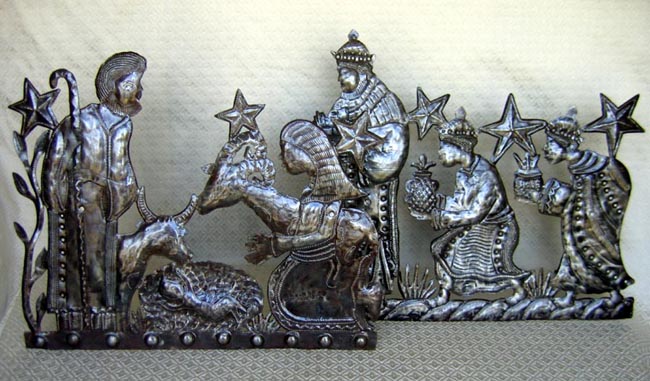OUR COLLECTION — LATIN AMERICA — HAITI 201. LARGE STEEL DRUM NATIVITY
This Nativity is two separate pieces of recycled steel oil drums. The first piece on the left depicts Mary and Joseph watching over baby Jesus. The family is flanked by a long-horn sheep and a goat. This scene measures 22 inches long by 18 inches tall.
The other piece depicts the three wise men who are approaching the Holy Family. They bring unique gifts, such as a pineapple. This piece measures 22 inches long by 19 inches tall. The various textures on both pieces made by hammering the metal from the reverse side are impressive.
Both pieces are signed by Exulien, the artist; he chiseled his name on the fronts of each piece.
55-gallon oil drums are Haitian artists’ raw materials. The process of converting oil drums into sculptures is both a tribute to man’s imagination and resourcefulness in the face of dire economic needs. The artist first removes both ends of the oil drum. The ends are used for smaller sculptures. Next, the drum is stuffed with straw and lit on fire to burn off any residues. When it cools down, it is sliced down one side and flattened into a four-by-six-foot piece of metal canvass. With a stick of chalk, the artist draws out an image on this metal sheet. Next, with only a hammer and a chisel, the design is cut and the sculpture is made.
Because Haiti is one of the poorest countries in the world (the poorest in the Western Hemisphere), continuing orders for handicrafts are very important for artisans to provide basic needs for their families.
The other piece depicts the three wise men who are approaching the Holy Family. They bring unique gifts, such as a pineapple. This piece measures 22 inches long by 19 inches tall. The various textures on both pieces made by hammering the metal from the reverse side are impressive.
Both pieces are signed by Exulien, the artist; he chiseled his name on the fronts of each piece.
55-gallon oil drums are Haitian artists’ raw materials. The process of converting oil drums into sculptures is both a tribute to man’s imagination and resourcefulness in the face of dire economic needs. The artist first removes both ends of the oil drum. The ends are used for smaller sculptures. Next, the drum is stuffed with straw and lit on fire to burn off any residues. When it cools down, it is sliced down one side and flattened into a four-by-six-foot piece of metal canvass. With a stick of chalk, the artist draws out an image on this metal sheet. Next, with only a hammer and a chisel, the design is cut and the sculpture is made.
Because Haiti is one of the poorest countries in the world (the poorest in the Western Hemisphere), continuing orders for handicrafts are very important for artisans to provide basic needs for their families.
